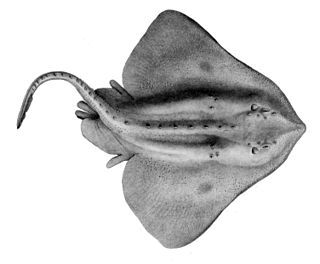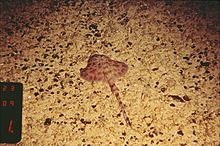
Skates are cartilaginous fish belonging to the family Rajidae in the superorder Batoidea of rays. More than 150 species have been described, in 17 genera. Softnose skates and pygmy skates were previously treated as subfamilies of Rajidae, but are now considered as distinct families. Alternatively, the name "skate" is used to refer to the entire order of Rajiformes.

The guitarfish are a family, Rhinobatidae, of rays. The guitarfish are known for an elongated body with a flattened head and trunk and small, ray-like wings. The combined range of the various species is tropical, subtropical, and warm temperate waters worldwide.

Rajiformes is one of the four orders in the superorder Batoidea, flattened cartilaginous fishes related to sharks. Rajiforms are distinguished by the presence of greatly enlarged pectoral fins, which reach as far forward as the sides of the head, with a generally flattened body. The undulatory pectoral fin motion diagnostic to this taxon is known as rajiform locomotion. The eyes and spiracles are located on the upper surface of the head and the gill slits are on the underside of the body. Most species give birth to live young, although some lay eggs with a horny capsule.

Bathyraja is a large genus of skates in the family Arhynchobatidae.

Dipturus is a large genus of skates native to the Pacific, Atlantic, and Indian Oceans. They were formerly included in Raja. Some species initially moved to Dipturus were later placed in Dentiraja, Spiniraja, and Zearaja.
Notoraja is a genus of skates in the family Arhynchobatidae. They are found in deep water in the Indian and western Pacific Ocean.
Gurgesiella is a genus of fish in the family Gurgesiellidae. These relatively small deep-water skates are found in the Atlantic and Pacific Oceans off South and Central America.

Neoraja is a genus of fish in the family Rajidae found in the Atlantic Ocean. These small, deep-water skates all reach a total length of approximately 30 centimetres (12 in).
Rostroraja is a genus of skate belonging to the family Rajidae, native to the Atlantic Ocean and East Pacific, including the Mediterranean, Caribbean, Gulf of Mexico and Gulf of California. The genus was considered monotypic in the past, but a number of species usually classified in Raja have been reassigned to this genus based on genetic analysis.

Arhynchobatidae is a family of skates and is commonly known as the softnose skates. It belongs to the order Rajiformes in the superorder Batoidea of rays. At least 104 species have been described, in 13 genera. Softnose skates have at times been placed in the same family as hardnose skates, but most recent authors recognize them as a distinct family. Members of the Arhynchobatidae can be distinguished from hardnose skates in having a soft and flexible snout, as well as a more or less reduced rostrum.

Neoraja caerulea, also known as the blue ray or blue pygmy skate, is a species of fish in the family Rajidae. This small ray reaches a total length of approximately fish 30 centimetres (12 in) and is endemic to the north-eastern Atlantic Ocean off Ireland and Iceland, and south to the Bay of Biscay. It occurs at depths of 600 to 1,262 metres.

Batoidea is a superorder of cartilaginous fishes commonly known as rays. They and their close relatives, the sharks, comprise the subclass Elasmobranchii. Rays are the largest group of cartilaginous fishes, with well over 600 species in 26 families. Rays are distinguished by their flattened bodies, enlarged pectoral fins that are fused to the head, and gill slits that are placed on their ventral surfaces.
Cruriraja is a genus of skates in the family Gurgesiellidae. They are primarily found in the warm West Atlantic and off southern Africa, but C. andamanica is from the Indian Ocean.

Fenestraja is a genus of eight species of skate in the family Gurgesiellidae. They are found in deeper waters of the western Atlantic and the Indian Ocean.

Trygonorrhinidae, the banjo rays, is a family of rays, comprising eight species in three genera. They were formerly classified in the family Rhinobatidae.
The Melbourne skate is a species of fish in the belonging to the skate family Rajidae. It is endemic to southern Australia. Its natural habitat is open seas. It is found at depths up to 345 meters.
The panrays are a genus, Zanobatus, of rays found in coastal parts of the warm East Atlantic Ocean, ranging from Morocco to Angola. It is the only genus in the family Zanobatidae, which traditionally has been included in the Myliobatiformes order, but based on genetic evidence it is now in Rhinopristiformes or a sister taxon to Rhinopristiformes.
Gurgesiella atlantica, commonly known as the Atlantic pygmy skate, Atlantic finless skate, or simply the Atlantic skate, is a skate species in the family Gurgesiellidae. It lives in the western central and southwest Atlantic Ocean, from Nicaragua to Brazil. It grows to 49 centimetres (19 in) – 52 centimetres (20 in) long and is distinguished from other skates by its long, slender tail and absence of dorsal fins.









